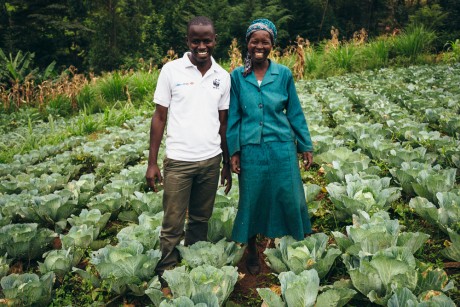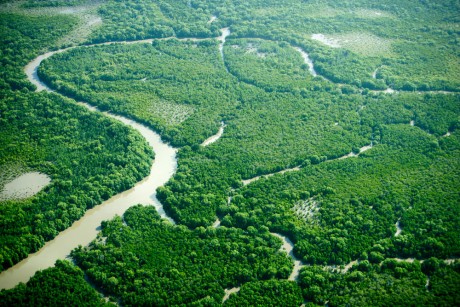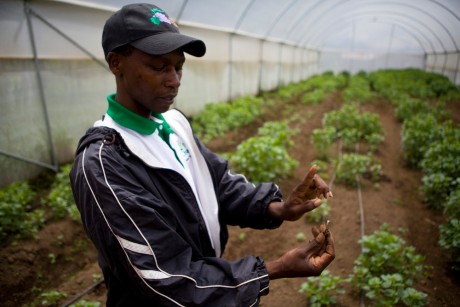The Agriculture/Environment Interface in Africa
From farm to table, almost every transaction in the food value chain has wide ranging impacts on nature and the environment. Food systems across Africa are leading to invasion and degradation of forests, savannahs and wetlands, as well as polluting water, “mining” soils and producing greenhouse gases (GHGs) in ever-increasing amounts. Total arable land in use in Sub-Saharan Africa has increased from 133 million hectares four decades ago to 240 million hectares in 2020. By 2050, the Food and Agriculture Organization of the United Nations estimates that this could increase to 291 million hectares. Land degradation and fragmentation of landscapes is having major consequences for wildlife, biodiversity and ecosystem services on which communities depend – such as healthy watersheds. Africa is also vulnerable to climate change with frequent, severe climate shocks like drought, floods and extreme temperatures, and GHG emissions from agriculture contributing more than 30% to the national GHG inventory. Last but not least, agriculture is the largest consumer of water in sub-Saharan Africa.


Urban Agriculture
Urban populations are growing faster in Africa than all other regions of the world. Africa’s population will be 2.5 billion in 2050 compared to 1.3 billion in 2020! It is likely that the new urban population will demand more access to dairy and meat products, as well as to cereals, vegetables and fruits, fats, oils and sugars than the previous generation did, which resided largely in rural areas. Feeding Africa’s cities, and providing access to good quality food, presents a major challenge. However, it also means a major opportunity for the continent’s 60 million farms. Out of total urban food sales of roughly US$200 to US$250 billion per year, over 80% comes from domestic African suppliers. The most rapidly growing urban food markets are for processed, prepared, and perishable foods — especially dairy, poultry, meat, fish, and horticulture.
In Kenya, statistics from the University of Nairobi indicate that about 30% of households in Nairobi benefit from urban and peri-urban agriculture, such as vertical gardens and hydroponics, which provide 60% of the leafy vegetables and 70% of milk and poultry products to consumers in Nairobi. Approximately 30% of the population in Nairobi is engaged in urban farming, and urban and peri-urban farmers control an estimated 75% of the vegetable value chain in urban Kenya.
In Dar-es-Salaam, Tanzania’s capital, urban agriculture comprises at least 60% of the informal economic sector and is the second-largest urban employer.
In Uganda, COVID 19 lockdowns and transport restrictions have disrupted the links between rural and urban areas, threatening the city’s food security. In response, urban and peri-urban farmers have begun catering to the city’s numerous food markets. In Kampala for example, during lockdown, over 65% of Kampala’s vegetable supplies have been provided by the sector. For some low-income households, bearing a hand in these urban farming activities, the lockdown has meant new sources of income.
_0/index.jpg?itok=JX_KFSwB)
Innovations in Urban Agriculture
The dual burden of increasing food demand and rising food climate footprint makes scaling up innovations in sustainable agriculture intensification (SAI) crucial and urgent. The Commission on Sustainable Agriculture Intensification (CoSAI) is pushing for improved investments in innovation for SAI in the Global South.
There is a strong need to pay more attention to certain innovation areas, such as our diets, reducing food waste, and improving the way we produce our food.
According to a recent report by McKinsey, following a green revolution model, Sub-Saharan Africa will need eight times more fertilizer, six times more hyrbid seeds, at least $8 billion of investment in basic storage (not including cold-chain investments for horticulture or animal products), and as much as $65 billion in irrigation to fulfil its agricultural potential of producing 2 to 3 times more cereals and grains to feed urban markets. Achieving this level of potential without damaging the environment and while supporting social equity will require implementing innovations in technology, institutions and policies.

Environmental Benefits of Innovations
Urban and peri-urban farms provide an opportunity for innovation that could result in various positive environmental impacts:
- Less land converted because of the space efficiency of urban farms, especially vertical farms, compared to traditional farms in rural areas.
- Reduced food mileage by localizing produce and limiting the distance food travels from farm to fork. Globally, the average meal has traveled 4,200 miles just to get to the consumer’s table, and some imports in Africa such as rice and chicken come all the way from Thailand and Brazil. A 2019 analysis by McKinsey looking at major agricultural-input chains in eight African countries, found that inputs changed hands at least three times before they reached the farmer, moving from national importers to regional distributors to “agro-dealers” (which are typically small, rural shops). On average, this fragmented supply chain led to a 20 to 50% mark-up over import price across major agricultural inputs, with about one-third to one-half of that captured as margin by the distributors and retailers in the chain.
- Improved water recycling where rainwater tanks are utilised to collect the rainwater from the city roofs, which is then stored and pumped into the gardens as needed.
- Increased pollination where urban gardens that have more flowers and trees, which allows insects and animals to help with pollination and improve the overall environmental status of the area. And in some cases, gardens can serve as a biodiversity refuge for wildlife and insects.
- Reduced air pollution by removing pollutants which are in the air such as chemicals and allergens like pollen. And reduced noise pollution especially where green roofs and vertical gardens absorb sound waves through the soil and plants.
Another important area of innovation concerns ensuring food safety. Land in the urban environment can sometimes be contaminated with many pollutants, including lead and a range of toxic hydrocarbons, and water may be contaminated with human pathogens.
Getting to Scale
Integrating Sustainable Agriculture into City Development Plans: Food systems need to become part of mainstream urban and territorial planning. For example: Kampala’s Governing authority has integrated urban agriculture into the city’s Slum Development Plans. The city officials view this also as a solution for youth unemployment and there are already efforts underway to train the youth how to carry out vertical farming in small spaces.
Promote City Region Food Systems Approaches: As Africa’s food systems move to urban areas, new actors — including mayors, city councils, district governments, urban planners, public health officers, and industry trade associations — have become central to shaping food policy. This requires a new form of governance, consultation, and coordination. City region food systems approaches foster the development of resilient and sustainable food systems within urban centres, peri-urban and rural areas surrounding cities by strengthening rural-urban linkages. The One City Region Food System (CRFS) programme is implemented in Kigali (Rwanda), Colombo (Sri Lanka), Antananarivo (Madagascar), and Tamale (Ghana). In Kitwe and Lusaka (Zambia) the result of another CRFS process is a proposal to integrate food in the National Zambian Urban Policy currently under development (FAO).
Integrating Actions on Sustainable Food Systems into National Climate Plans (NDCs): A new report by WWF, UNEP & EAT argues that countries are missing significant opportunities to reduce greenhouse gas emissions and identifies 16 ways policymakers could take more action, from farm to fork including reducing land-use change and conversion of natural habitats, which could reduce emissions by 4.6 Gt CO2e per year. Although 89% of NDCs mention agriculture production, actions in the food system, such as reducing food loss and waste, or shifting to more sustainable diets, are widely ignored, despite presenting the combined opportunity to reduce emissions by as much as 12.5 Gt CO2e – the equivalent of taking 2.7 billion cars off the road. Innovations in technology, investment, and policy are needed to find scalable solutions to achieve emissions reductions in these areas.
The African Development Bank Group estimates that if innovation in food systems is fully implemented, Africa can expect to double its maize production from a current 50 million metric tons per annum to 100 million metric tons, to triple soybean production from less than three million metric tons to nine million metric tons, and to double livestock production from 8.5 million metric tons to 16 million metric tons by 2025. The Africa Digital Revolution, evidenced by the penetration of mobile money – is already powering new business models in agriculture. We can build on this by ensuring innovations being deployed in Africa’s food systems help farmers produce food more sustainably with greater intensification, producing more with less while using technology that can help farmers increase productivity without negatively impacting nature or the environment.
Image captions & credits: Cover Image: Farmers selling maize in Bomet County in Kenya (photo by WWF); 1. The coastal zone of the southern region of Toliara in Madagascar (photo by WWF); 2. Nancy Ronoand and Kennedy Onyango are farmers in Bomet County in Kenya (photo by WWF); 3. Willard Charawe Maina holding a plant grown by hydroponics (Kilimo News, photo by Farm Africa); 4. The Rufiji river snakes through mangrove forest at its delta in Tanzania (photo by WWF); 5. Patrick Chege is a member of the Mkungi Floriculture Group Lake Naivasha in Kenya that grows organic flowers (photo by WWF)

*This blog is based on remarks delivered by the author at the Roundtable organized by CoSAI at the African Green Revolution Forum (AGRF).
To watch the CoSAI Roundtable at AGRF, click here.
To learn more about CoSAI, click here.
**Commissioners' perspectives are their own and are not considered as collective or endorsed CoSAI position statements.
_0/index.jpg?itok=vesVzUHI)
